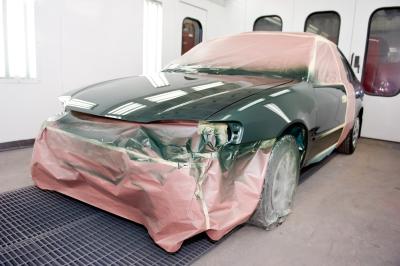
Using an airbrush to paint a car, or even simply using it to touch up dents or scratches, can be a complicated process if you have no previous experience. However, airbrushing will allow for the most control over the look of your car's finish. With some practice and patience, you can achieve the skills necessary to use the airbrush efficiently and make your car look like new.
Clean your car thoroughly to eliminate any dust or debris that may be accumulated in the scratches or dents. Use a tack rag to wipe all the dirt away and leave no fibers.
Determine the color of the paint that you will be using by testing many paint samples. Many times, paint will be one color when applied and then fade or brighten after drying. The color may also become enhanced with multiple layers of the same color, which is recommended, so take that into effect. Use a similar piece of material to test your airbrush paint on, allowing it to dry and then comparing to the car you are working on.
Mask off the areas that you will be retouching.
Apply primer to the area in smooth, even strokes. If using airbrush primer, simply spray it on as you would with airbrush paint (how to apply and use the airbrush is in Step 6).
Sand the primer down after allowing it to dry completely. Sand it first with 220-grit sandpaper and then the 600. Wipe it down again with a tack rag to eliminate any debris that accumulated while sanding.
Airbrush your color onto your vehicle where you would like to touch it up. To use the sprayer, hold the airbrush gun with your dominant hand and use your other hand to steady it. You want a steady motion with your hands so that you don't have uneven painting or spots of paint that are more dense than others. On the top of the airbrush will be a button or lever. Press the lever (or button) and this will open the valve and allow the air to flow through the nozzle, shooting paint out. Depending on how hard you press the lever determines how much paint is expelled from the gun. Press it and spray level, even strokes on the area you wish to touch up.
Let the first layer of paint dry. Remove the masking and reapply it. Reapply the masking after every coat of paint to make sure that you are not moistening the tape, causing it to buckle or fold, and therefore allowing paint to seep under it.
Paint a second coat directly over the first coat, allowing that to dry as well. Determine if your car needs a clearcoat/glossy finish. If your car shines normally, it is a good idea to apply a new clearcoat over your paint layers, but if your car has a smoother, more matte finish, forgo the clearcoat finish.